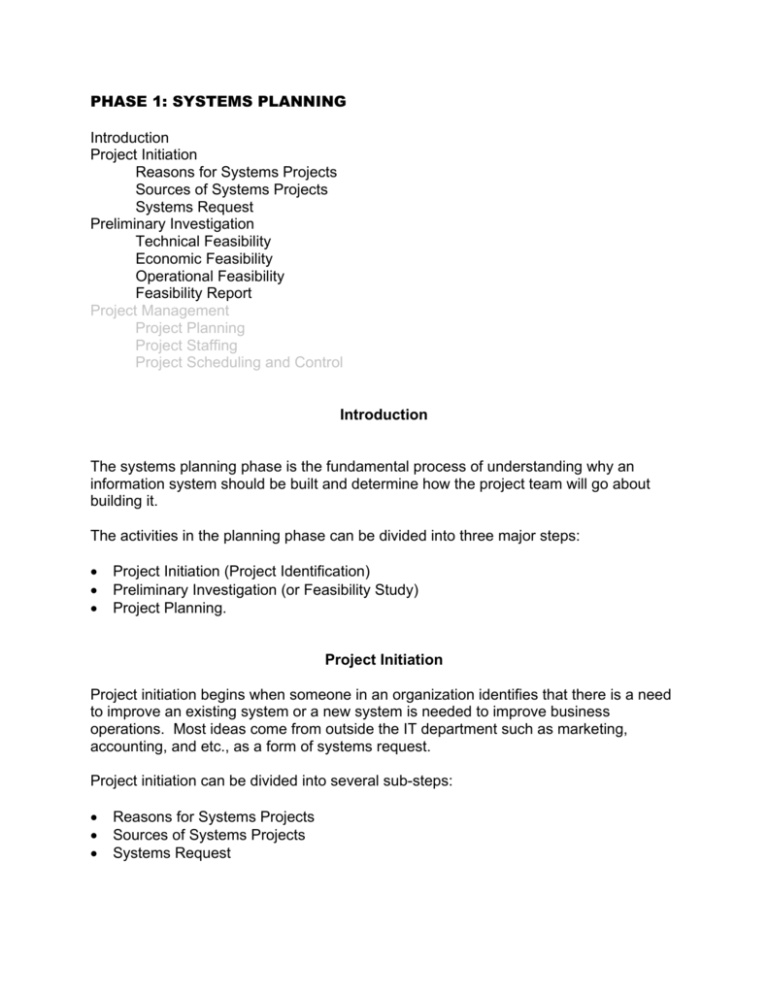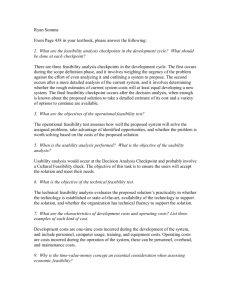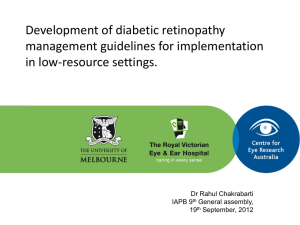SYSTEMS ANALYSIS & DESIGN
advertisement

PHASE 1: SYSTEMS PLANNING Introduction Project Initiation Reasons for Systems Projects Sources of Systems Projects Systems Request Preliminary Investigation Technical Feasibility Economic Feasibility Operational Feasibility Feasibility Report Project Management Project Planning Project Staffing Project Scheduling and Control Introduction The systems planning phase is the fundamental process of understanding why an information system should be built and determine how the project team will go about building it. The activities in the planning phase can be divided into three major steps: • • • Project Initiation (Project Identification) Preliminary Investigation (or Feasibility Study) Project Planning. Project Initiation Project initiation begins when someone in an organization identifies that there is a need to improve an existing system or a new system is needed to improve business operations. Most ideas come from outside the IT department such as marketing, accounting, and etc., as a form of systems request. Project initiation can be divided into several sub-steps: • • • Reasons for Systems Projects Sources of Systems Projects Systems Request Reasons for Systems Projects In this section, we discuss the main reasons for systems projects, which are described below. Improved service Systems requests are often aimed at improving service to customers, suppliers, or users within the company. A bank or a mutual fund company may want to allow their account holders to check account balances from the company Web sites, or a university may want to create an online registration system. Better performance The current system might not meet performance requirements. For example, the systems might be old and hence slow to respond data inquiries, have limited flexibility, or be unable to support company growth. System performance can be increased by combining processes, streamlining a process through the elimination of unnecessary or duplicated steps, integration of systems and sub-systems, and so on. More information The system might produce information that is insufficient, incomplete, or unable to provide company’s changing information need. For example, a system that tracks customer orders might not be capable of analyzing marketing needs. The business might need to keep track of some key information that can not be obtained from the current system. 2 Stronger controls A system may not have all controls on accurate data entry, leading to inaccurate data entry and storage, loss of income, and even system failure. A system may not have all security required by the company for different users. Common user controls include login passwords to programs and databases, various levels of systems access (menus level, form level, field level, etc.) Reduced cost The current system could be expensive to operate and maintain as a result of technical problems, design weaknesses, or the changing demands of the business. 3 Sources of Systems Projects Initiation or request of systems projects may come from various areas, both internal and external to an organization. Following are some of the sources. User requests Users of a company work usually with the systems and interact with customers on a daily basis. They are the most likely source for improved or new systems request. Users may experience that the current system is not flexible and it is difficult to learn. They might experience that the system does not produce information required by the company business. For example, users may request a new Web site to market company products, a more powerful sales analysis report, a network to link all production locations, or an online system for customers to obtain instant status for their orders. Top-management directives Directives from top managers could generate a systems request. These can originate due to new company objectives, a need for improved reports to make strategic decisions. Existing systems Errors or problems with existing systems can trigger requests for systems projects. Information systems department Systems project request can come from the information systems department as suggestions. This is possible if IS staff members such as CIO (chief information officer) and managers are involved with company operations and user needs. External factors There are many external factors can cause changes to an existing system or creation of a new system. Examples are: • • • • Changes in government tax regulations and reporting requirements. New releases or version of software packages used in the existing systems. Competitors offering of new products and services such as online banking or technical support through telephone or Web site. Advances in technology: For example, installation of a new scanning system to automate retail sales. 4 Systems Requests from Internal and External Sources 5 Systems Request Every organization has its own way of initiating a project, but most start with a technique called systems request. Systems request documents the business reasons for building the system and the value that the system is expected to provide. When the project is initiated, business users complete this form as part of the system approval process within the organization. Most system requests include four elements: project sponsor, business need, functionality, and expected value. Project Sponsor The project sponsor is the person who has an interest in seeing the system succeed, someone who will work throughout the SDLC to make sure that the project is moving in the right direction from the perspective of the business. Usually this is the person who initiated the project and who will serve as the primary point of contact for the system on the business side. Business Need It describes why the information system should be built (in terms of business point of view) and explains to the approval committee why the organization should fund the project. The business need should be clear but concise. Functionality The functionality or features of the system should be described in a concise language. For example, the ability to collect customer orders from the Web or automatic collection of claim files from provider (hospitals, doctors) computers through dial-in service. Expected Value Expected value to be gained from the system should include both tangible and intangible value. Tangible value can be quantified and measured (e.g., 10% reduction in operating costs, 50% reduction in time for tax forms processing). 6 An intangible value results from an intuitive belief that the system provides important but hard-to-measure benefits to the organization (e.g., improved customer service, organized reports, fewer reports, on-line reports, faster claims processing, reduced paper-document processing). Defining expected value is important, as when the system is built, the performance of the system can be compared with the original goal. Special Issues or Constrains Special issues or constraints of the system should be included in the system request. For example, the project may need to be completed by a specific deadline. Once the system request is completed, it is sent to the approval committee, which could be an Information Systems steering committee that meets regularly to make information systems decisions, a senior executive who has control or organizational resources, or any other decision-making person or body. 7 Sample System Request Form 8 Preliminary Investigation (or Feasibility Study) If the project is approved for preliminary investigation, an analyst from the IT department is assigned to perform preliminary investigation. The analyst might be part of the organization or from a contracted software development company. His or her purpose is to identify clearly the nature and scope of the problems, opportunities of improvement, and define specific solutions. We will discuss this in detail in the analysis phase. To accomplish the preliminary investigation, the analyst embarks an activity called feasibility Study (or feasibility analysis). Because this is a preliminary investigation, the time for this study is short, of the order of few weeks. Feasibility analysis guides the organization in determining whether to proceed with a project. It also identifies the important risks associated with the project. As with the systems request, each organization has its own process or format for feasibility analysis but most include three processes: technical feasibility, economical feasibility, and operational feasibility of the project. Activities in this phase include interviewing prospecting users and management, summarizing the knowledge obtained, estimating the scope of the project, and documenting the results in a feasibility report that presents findings and recommendations. In the following, we describe the key aspects of the feasibility analysis: • • • • • Technical feasibility Economical feasibility Operational feasibility Schedule feasibility Feasibility report. 9 A Feasibility Analysis Includes Tests for Economic, Technical, and Operational Success. 10 Technical Feasibility Technical feasibility assesses the possibility of success and failure of the project. A system request is technically feasible if the organization has the resources to develop (or purchase), install, and operate the system. To assess technical feasibility, an analyst must consider the following: • Does the organization have the technical resources such as computer hardware, software, development tools, and other related equipment to either upgrade or install a new system that meets the requirement. • Does the organization have the needed technical expertise? If not, can it be acquired? Some of the other points to consider are: • Implementation of new technology: Implementation of new hardware and software takes longer than the existing ones, because time will be spent to familiarize the new technology. • Project Size and features: Large projects are riskier because they are complex and hard to manage. Economic Feasibility A systems request is economically feasible if the projected benefits of the proposed system outweigh the estimated costs involved in developing (or purchasing), installing, and operating it. The economic feasibility can be understood from a cost/benefit analysis, which identifies costs and benefits associated with the project, assigning values to them, and then calculating the net benefit. There are many well-known techniques for comparing the costs and benefits of a project. They include: • break-even analysis, • payback analysis, • cash-flow analysis, and • present value analysis. 11 Cost/Benefit Analysis Identifying Costs and Benefits: Costs and benefits can be tangible or intangible. Tangible costs or benefits can be measured in dollar values, intangible cost or benefits can not be measured. There are two main types of tangible costs: Developmental cost and operational cost. 12 The developmental costs are one time expense that is incurred during the construction of the system. They include expenses such as: • • • • Salaries for the project team Hardware and software expenses Training and consultant fees Office space, equipment, light, gas, A/C, papers, and other costs. Operational costs are those tangible costs that are required to operate the system. It includes variable expenses such as: • • • • Salaries for operating staff Software licensing fees Equipment upgrades Communication charges. The tangible benefits include revenues and cost savings such as: • • • Increased sales Reduction of inventory Reduction in staff. Intangible costs and benefits are hard to measure, but they should be considered. 13 Comparing Costs and Benefits There are many well-known techniques for comparing the costs and benefits of a project. They include break-even analysis, payback, cash-flow analysis, return on investment, and present value. Break-Even Analysis: • • • The point at which the costs of the current system and of the proposed system intersect represents the break-even point, i.e., where it becomes profitable for the business to get the new information system. The cost of the current system includes the cost of the operation of the system. The cost of the proposed system includes the cost of the development of the system and the operation of the system after development. 14 Payback Analysis: • • • • It is an estimation of time (number of years) that will take, to pay back the costs of developing the system. It assesses whether a business should invest in a proposed information system. Payback can be determined in either increasing revenues or increasing savings. A combination can also be used. If the proposed system has a projected payback of six years and the company wants to get paybacks in 4 years, the system will be rejected. 15 16 Cash-Flow Analysis: • • • • • • Cash-flow analysis examines the direction, size, and pattern of cash flow that is associated with the proposed system. It uses total revenue and total cost to calculate cash flow. Cash Flow = Total Revenue (or Benefits) – Total Cost For a new information system, the cost is very high during the developmental phase of the project. After that phase, the cost is mainly associated with the operation and maintenance of the system. Thus cost levels of after few years. Cash-flow analysis is used to determine when a company will begin to take profit. Refer to page 26 of the text. Determine Return On Investment (ROI): The return of investment is a calculation that measures the amount of money an organization receives in return for the money it spends – a high ROI results when benefits far outweigh costs. 17 Present Value Analysis: • • • • • It is a comparison of today’s costs with future costs and today’s benefits with future benefits. An investment of $100 today, at an interest rate of 8%, will result in $108 one year from today. Alternatively, one might ask, how much money needs to be invested today, in order to grow to $100 one year from today. This is the concept of present value analysis. The present value of a future dollar is the amount of money that, when invested today at a specified interest rate, grows exactly one dollar at a certain point in the future. The specified interest rate is termed as discount rate. The present value (PV) of a dollar n years from now at a discount rate (i) is calculated as: PV = 1/(1 + i)n. • • • Thus the present value of $1 five years from now at 6% is $0.747. In present value analysis, a company uses a discount rate that represents the rate of return if the money is put into relatively risk-free investments, such as bonds, instead of being invested in the project. Most companies require a rate of return that is higher than the discount rate because the degree of risk in any project. 18 19 Operational Feasibility (or Organizational Feasibility) Operational feasibility measures the suitability of the proposed system with regard to human factors. It is an assessment of the acceptance (or rejection) of the system by the people within the organization. It is found by addressing the questions such as: • Does management support the project? • Does users support the project? • Does the users see the change necessary for the project? • Does the new system need training for the users? If so, is the company ready to provide training? • Will the user support the project in every phase of the development? • Will the new system result in workforce reduction? • Will the new system place any change in the organization structure? • Do any legal or ethical issues need to be considered? A system might be feasible in terms of economic and technical analysis, but if the users do not cooperate with the changes, it may not be feasible operationally. Feasibility Report After conducting a preliminary investigation, the analyst submits a feasibility report to the approval committee. He also makes a presentation of the report. The objective of this report is to determine whether the project is feasible, i.e., whether to invest significant resources for further study or not. The feasibility report usually includes a problem definition, summary, proposed solution, preliminary cost-benefit analysis, and so on. If the committee approves the project, then the next step of the systems planning occurs – project management. 20







